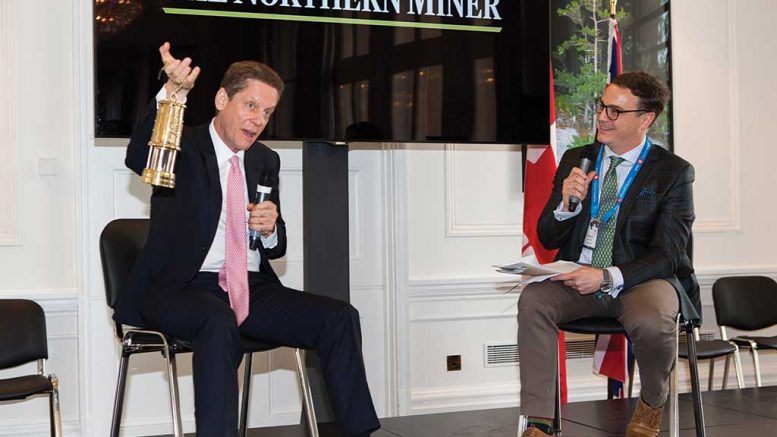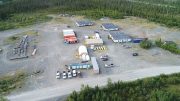VANCOUVER — Robert Friedland, executive chairman of Ivanhoe Mines (TSX: IVN, US-OTC: IVPAF), was in fine form during his presentation at the Sprott Natural Resource Symposium in Vancouver in mid-July. The promoter had a clear if familiar message for the hundreds of investors and mining executives in attendance: the energy revolution is here, metals are the “new oil,” and Ivanhoe — with its three tier-one mining assets — is ready to capitalize on the industrial transformation at hand.
Friedland expressed his excitement with Ivanhoe’s new Chinese partner, Beijing-based CITIC Metal, a subsidiary of the massive state-owned conglomerate CITIC. The $723-million private placement gives CITIC Metal a 19.9% stake in Ivanhoe, supplanting Friedland as the company’s largest shareholder. That gives CITIC Metal the right to appoint two directors to an enlarged Ivanhoe board — most likely one of whom will be CITIC Metal’s president Sun Yufeng, who would become co-chairman of Ivanhoe with Friedland.
“That’s probably the best purchase of a mining asset in the last 30 years,” Friedland said. “These people have a lot of money, and they’re very serious. Chinese people never overpay. They’ve had 5,000 years of mercantile history and they’re looking for a bargain.”
CITIC is not the only source of Chinese capital Friedland has tapped to help develop Ivanhoe’s assets.
He had George Fang, executive director of Beijing-based Zijin Mining Group, seated next to him during the presentation. Zijin holds a 9.9% stake in Ivanhoe Mines and a 39.6% stake in the Kamoa-Kakula copper project in the Democratic Republic of the Congo (DRC) — a joint venture between Zijin, Ivanhoe and the DRC government. After the CITIC deal, Zijin exercised its non-dilution rights, kicking in another $78 million. Both CITIC and Zijin bought shares at $3.68 per share, a 42% premium over Ivanhoe’s price at the time of Friedland’s speech. Ivanhoe’s stock is trading at $2.50 per share, a long way from the $4 to $5 per share range it traded in 2017.
To Friedland, it is but a sign of the good times ahead: “Financial markets always conspire to fool the largest number of participants. This is the nature of financial markets, and that’s why your instincts and the conclusions you reach when you read a newspaper are almost always wrong. When oil hit $25 per barrel in 2015, the Wall Street Journal and all the other newspapers that are good for wrapping dead fish on the third day were talking about $10 or $20 per barrel oil. And look what happened to the price of oil. Nobody expected that.”

The headframe at Shaft 1 at Ivanhoe Mines’ Platreef PGM project in South Africa. Credit: Ivanhoe Mines.
As with oil, so with Ivanhoe’s stock, Friedland suggested. The fundamentals, he insisted, are clear.
To start, demand for the minerals Ivanhoe plans to mine is set to explode as a result of unstoppable and metal-intensive socio-economic changes coming “tomorrow morning” — most especially urbanization and the energy revolution, including the growth of electric vehicles (EVs).
“Two-point-four-billion people will be moving to cities in the next few decades. That’s 2,400 million people moving to cities. The growth is incredible because of the city lights, the nightclubs, the good food, the dancing girls. People head for the cities. It’s hard to stay out in the countryside growing vegetables when the cities are so exciting.”
In addition to the metals demand generated by urbanization — apartment construction, air conditioners, refrigerators, televisions, etc. — there’s the energy revolution and its need for metal-intensive batteries.
“China’s going to make 60 million cars per year. If 10% of them have a fuel cell, that would be equal to world production in platinum. And about 60% of platinum mines today are losing money at the current platinum price. That’s the kind of economics you want to find.”
Copper demand for EVs is going to rise ninefold in the next few years, Friedland said.
“When you cut apart a lithium-ion battery, it’s mainly copper,” he said. “When you look at a Tesla Model S battery and rip it apart, 80% of the battery is nickel, 15% of the battery is cobalt. These are the metals you want. These are the metals that China is worried about having in the event of a trade war. This is the new petroleum!”
Elon Musk may be the iconic figure of this new industrial world, but Friedland likes his spot at the table. “Who made the most money from Henry Ford’s iron horse? Who’s the guy who printed all the money? It was John D. Rockefeller.”
Ivanhoe is gearing up to capitalize on this incipient boom in demand with its three advanced sub-Saharan African copper-gold, zinc and platinum group metal projects.
“These are actually the three best development projects on this planet,” Friedland said. “No bullshit. We can say that to anybody. Nobody can put their hand up and deny it.”
First, there is the Kipushi high-grade zinc-copper project in the DRC’s Haut-Katanga province. Ivanhoe holds a 68% interest in Kipushi under a joint-venture agreement with the DRC’s state-owned mining company, Gécamines. As of an updated resource estimate released on July 30, measured and indicated resources at Kipushi, primarily in the Big Zinc zone, have increased to 11.78 million tonnes grading 35.34% zinc, 0.80% copper, 23 grams silver per tonne and 64 grams germanium per tonne, at a 7% zinc cut-off grade — or an estimated 9.2 billion lb. contained zinc.
Second, there is the Kamoa-Kakula project — a near-surface, stratiform copper deposit outside the city of Kolwezi in the DRC’s Lualaba province. Kamoa-Kakula has the same ownership structure as Kipushi — 68% owned by Ivanhoe and 32% owned by Gécamines.

Portals for twin declines at Ivanhoe Mines’ Kakula copper project in the Democratic Republic of the Congo. Credit: Ivanhoe Mines.
Said Friedland, “At Kamoa-Kakula we’re developing the richest copper discovery on the planet. This is the fourth largest copper discovery ever made by human beings already. We’re actually working now to target our head grade for the first six years at north of 10% copper — the highest copper grade of any mine in the world being built by an order of magnitude.”
Finally, there is the Platreef project on the Northern Limb of South Africa’s Bushveld Igneous Complex, the world’s premier platinum-producing region.
Said Friedland: “The Platreef mine is the largest precious metals mine in the world that can be mechanized. It’s by far the best precious metals mine [in the world]. Our number-one shaft is 750 metres deep. We touch the orebody in a few weeks. We’re going sideways now. We’re going to start at about 500,000 ounces of metal, a little more than that when you throw in the nickel and the copper. [It will be] the lowest-cost producer of platinum, palladium, gold, rhodium, nickel and copper in the world.”
“There are 42 million oz. of precious metal for phase one that has been drilled out and proven. This a high cut of 100 million ounces. These are real, proven reserves. Bottom of the world cost curve.”
The improving outlook for minerals and Ivanhoe’s three tier-one mining assets were not the only part of Freidland’s pitch. He was sure to drive home his connections to the upper echelons of governments all over the world.
Discussing Ivanhoe’s newest partner, CITIC, Friedland said, “CITIC has the tallest building in the capital of China. It’s really hard to get a permit to get the tallest building, because you’re taller than everybody else, so whatever company has the tallest building must have a lot of access to the powers that be. That’s our partner.”
As for Chinese President Xi Jinping, Friedland said, “We have a lot of people who know him quite well.”
The Platreef mine has seen the most local opposition of Ivanhoe’s three assets. Lucky for Friedland, he noted that “one of our directors, or former directors,” is none other than new South African President Cyril Ramaphosa.
Discussing the trade war that has sent Ivanhoe’s shares, in tandem with the prices of the commodities it plans to mine, tumbling downwards in recent weeks, Friedland remarked, “One man, one man launched this trade war. I know him. I’ve actually had dinner with ‘The Donald’. I don’t know how many of you have, but I’ve actually had dinner with him.”
Not to be left unheard, Friedland later questioned the audience, “How many people have actually had dinner with Donald Trump? Raise your hand.”
Gazing upon a silent crowd with the same unwavering vivaciousness that has made him the industry’s most legendary promoter, Friedland exclaimed, “Oh my God! I’m actually the only person in the room who has met the guy.”






Be the first to comment on "Friedland: Ivanhoe is ready for the energy revolution"